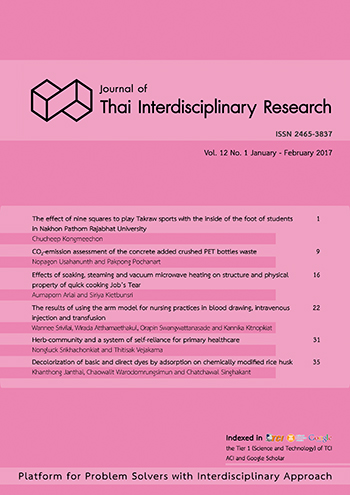Effects of soaking, steaming and vacuum microwave heating on structure and physical property of quick cooking Job’s Tear
Main Article Content
Abstract
Article Details
References
AOAC. (2000). Official Methods of Analysis of AOAC international. 17th ed, Association of Official Analytical Chemists, Arlington.
Arlai, A., Prienchob, P. and Thakam, S. (2013). Microstructure and physicochemical properties of job’s tear upon dry and moist heat treatments with vacuum microwave heating. Proceeding of the 15th food innovation asia conference 2013, Bangkok, Thailand, 137-146
Belitz, H. D., Grosch, W. and Schieberle, P. (2009). Food chemistry.4th ed. Springer, Berlin, 1077.
Bello, M. O., Tolaba, M. P. and Suarez, C. (2007). Water absorption and starch gelatinization in whole rice grain during soaking. LWT Food Science and Technology, 40: 313-318.
Bello, M., Baeza, R. and Tolaba, M.P. (2006). Quality characteristic of milled and cooked rice affected by hydrothermal treatment. J. Food Eng, 72 (2):124–133.
Centre for Agricultural Information Office of Agricultural Economic. (2011). Thailand foreign agricultural trade statistics 2011. Ministry of Agriculture and Co-operatives. Thailand. 1-135.
Chaisiricharoenkul, J., Tongta, S. and Intarapichet, K. O. (2011). Structure and chemical and physical properties of job’s tear (Coixlacryma-jobi L.) kernels and flours. Suranaree J. Sci. Technol, 18(2): 109-122.
Durance, T.D. and Wang, J.H. (2002). Energy consumption, density, and rehydration rate of vacuum microwave-and hot-air convection-dehydrated tomatoes. J. Food Sci, 67 (6): 2212-2216.
Figiel, A. (2009). Drying kinetics and quality of vacuum-microwave dehydrated garlic cloves and slices. J. Food Eng, 94: 98–104.
GiriS, K. and Prasad, S. (2007). Drying kinetics and rehydration characteristics of microwave-vacuum and convective hot-air dried mushrooms. J. Food Eng, 78: 512–521
Gujral, H. S. and Kumar, V. (2003). Effect of accelerated aging on the physicochemical and textural properties of brown and milled rice. J. Food Eng, 59: 117–121.
Keneaster, K. K. and Newtin, H. E. (1957). Process for producing a quick-cooking product of rice or other starchy vegetable. U.S. Patent. 2,813,769. Nov., 19.
Kuo, C.C., Chiang, W., Liu, G. P., Chien, Y. L., Chang, J. Y., Lee, C. K., Lo, J. M., Huang, S. L., Shih, M. C. and Kuo, Y. H. (2002). 2,2-Diohenyl-1-picrylhydrazyl radical scavenging active components from adley (Coixlachry-jobi L. Var. ma-yuenStapf) hulls. J. Agric. Food Chem, 50(21): 5850-5855.
Lin, T.M., Durance, T.D. and Scaman, C.H. (1998). Characterization of vacuum microwave, air and freeze-dried carrot slices. Food Res. Inter, 31: 111-117.
Nagao, T., Otsuka, H., Kohda, H., Sato, T. and Yamasaki, K. (1985). Benzoxazinones from Coixlacryma-jobi L. var. ma-yuen. Phytochem, 24: 2959-2962.
Numata, M., Yamamoto, A., Moribayashi, A. and Yamada, H. (1994). Antitumor components isolatedfrom the Chinese herbal medicine Coixlacryma-jobi. Plant Med, 60: 356-359.
Ozai-Durrani, A. K. (1955). Quick-cooking rice and process for making same. U.S. Patent. 2,438,939. Apr., 6.
Pereira, N.R., Marsaioli, A. and Ahrne, L. (2007). Effect of microwave power, air velocity and temperature on the final drying of osmotically dehydrated bananas. J. Food Eng, 81: 79–87.
Prabhanjan, D.G., Ramaswamy, H.S. and Raghavan, G.S.V. (1995). Microwave assisted convective air drying of thin layer carrots. J. Food Eng, 25(2): 283–293.
Prasert, W. and Suwannaporn, P. (2009). Optimization of instant jasmine rice process and its physicochemical properties. J. Food Eng, 95: 54-61.
Prienchob, P., Arlai, A. and Thakam, S. (2012). Microstructure, physicochemical properties of precooked- kidney bean (Phaseolus vulgaris L.), mung bean (Vignaradiata L.) and job’s tear (Coixlachryma – jobi L.) on heat moisture and freezing treatments, In the 4th International Science, Social Science, Engineering and Energy Conference2012. Publisher Kasem Bundit University, Thailand. P 46-52.
Rewthong, O., Soponronnarit, S., Taechapairoj, C., Tungtrakul, P. and Prachayawarakorn, S. (2011). Effects of cooking, drying and pretreatment methods on texture and starch digestibility of instant rice. J. Food Eng, 103: 258-264.
Robert, R. L. (1955). Preparation of pre-cooked rice. U.S. Patent 2,715,579. Aug., 16.
Schoeninger, V., Machado Coelho, S.R., Christ, D. and Sampaio, S.C. (2014). Processing parameter optimization for obtaining dry beans with reduced cooking time. LWT Food Science and Technology, 56: 49-57.
Sham, P.W.Y., Scaman, C.H. and Durance, T.D. (2001). Texture of vacuum microwave dehydrated apple chips as affected by calcium pretreatment, vacuum level, and apple variety. J. Food Sci, 66 (9): 1342-1347.
Swasdisevi, T., Sriariyakula, W., Tai, W. and Soponronnarit, S. (2010). Effect of pre-steaming on production of partially rice using hot-air fluidization technique. J. Food Eng, 96: 455-462.
Takahashi, M., Konno, C. and Hikino, H. (1986). Isolation and hypoglycemic activity of coixan A, Band C, glycans of Coixlacryma-jobivar. ma-yuen seeds. Plant Med, 52: 64-65.
Thostenson, E.T. and Chou, T.W. (1999). Microwave processing : fundamentals and applications. Composites Part A: Applied Science and Manufacturing, 30: 1055-1071.
Yousif, A.N., Scaman, C.H., Durance, T.D. and Girard, B. (1999). Flavor volatiles and physical properties of vacuum-microwave- and air-dried sweet basil (Ocimumbasilicum L.). J. Agric. Food Chem, 47: 4777-4781.
Waraluck, K., Wiwat, W., Suthaya, P. and Wichittra, D. (2011). Development of Job’s tears ice cream recipes with carrot juice and pumpkin paste. Maejo Inst. J. Sci. Technol, 5(3): 390-400.
Zhang, M., Tang, J., Mujumdar, A.S. and Wang, S. (2006). Trends in microwave related drying of fruits and vegetables. Trends Food Sci & Tech,17: 524-534.


